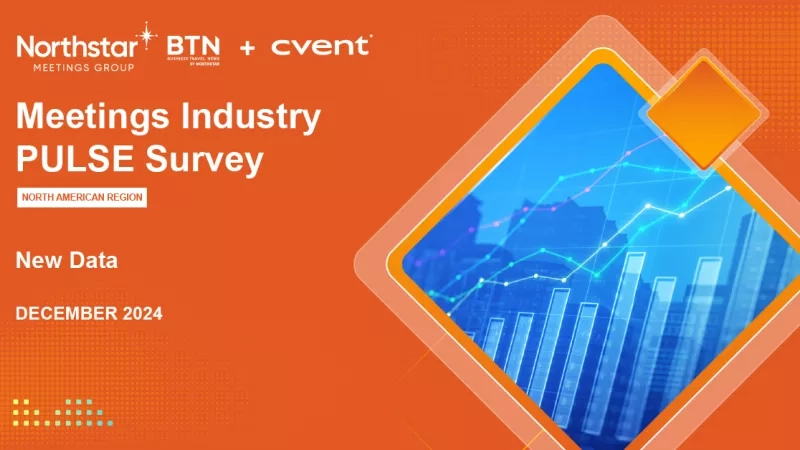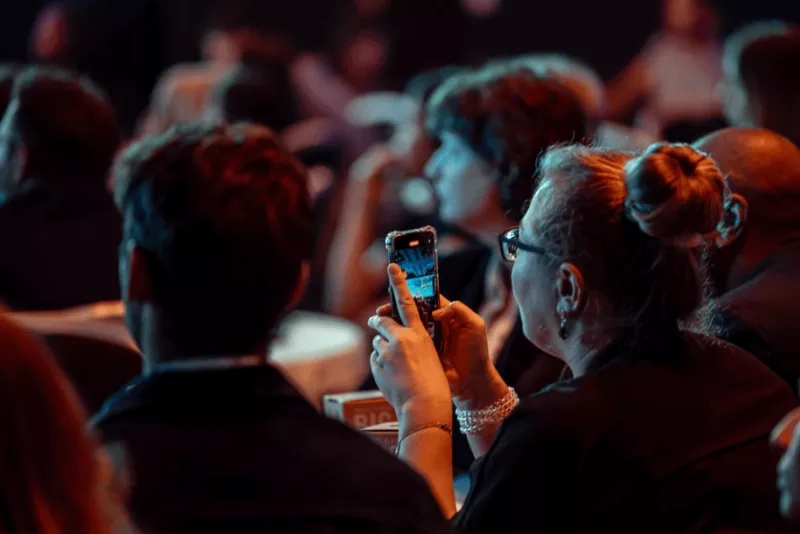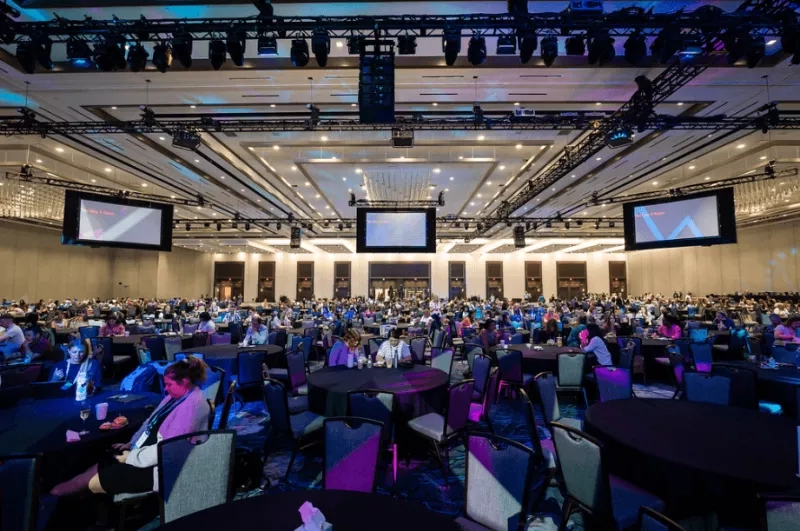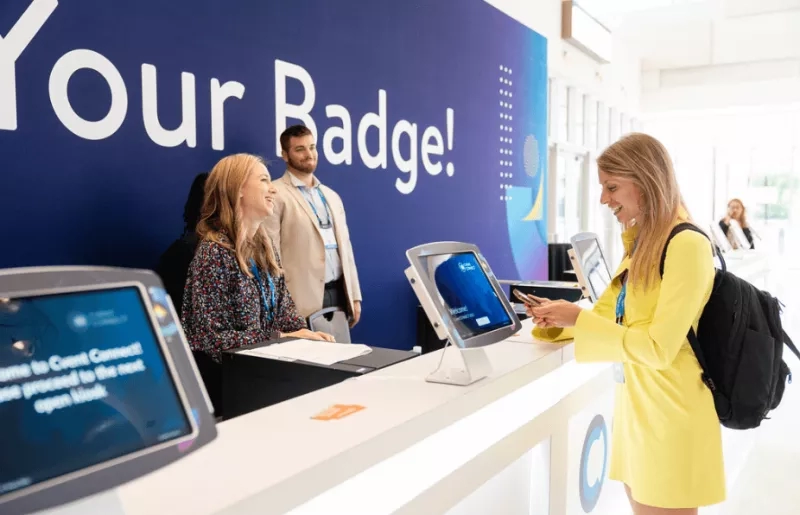Setting the stage for success in the events industry isn't just about picking the perfect venue or nailing the catering—it's about being goal-oriented from the get-go. With 56% of attendees planning to attend more events in 2025 than in 2024, the importance of delivering results remains high.
But where do you start?
Identifying clear, measurable objectives is one of the many event planning strategies that can turn every gathering, whether virtual, in-person, or hybrid, into a standout success. In this guide, we'll explain everything—from understanding event goals to setting and measuring them effectively.
What Are Event Goals and Objectives?
An event goal represents a desired, specific outcome you aim to achieve through your event, whether it's captivating attendees, connecting with a new audience, or driving business growth.
Conversely, objectives are smaller, more manageable tasks that help you progress toward your ultimate goal.
For instance, if your goal is to increase brand awareness, an objective might be to boost event registrations by promoting on social media. Objectives are smaller, bite-sized steps that help you reach your ultimate event destination.
Types of Event Goals for Corporate Events
Corporate event goals fall into two main categories: internal and external.
Internal event goals include things like:
- Boost teamwork and communication: Break down silos and encourage collaboration across departments, including sales, marketing, and finance.
- Strengthen company culture: Foster trust, connection, and a sense of belonging among employees.
- Drive innovation: Spark creativity and encourage employees to think outside the box.
- Align and educate: Ensure knowledge transfer and effectively communicate strategy changes.
External event goals include:
- Amplify brand awareness: Get your brand seen by a wider audience and establish thought leadership.
- Attract new customers: Generate leads and convert them into loyal customers.
- Build brand loyalty: Turn satisfied customers into enthusiastic brand ambassadors.
- Increase revenue: Drive sales through cross-selling, up-selling, and other promotional strategies.
What are SMART Event Goals?
SMART goals are an invaluable tool for event organizers, enabling them to establish specific objectives during event planning. Introduced in 1981 by consultant George T. Doran in a Management Review article, the SMART acronym stands for:
S - Specific
M - Measurable
A - Attainable
R - Relevant
T - Time-bound
In the context of event management, it empowers planners to avoid ambiguous goals like "I want my next event to be more successful." The term "successful" is too vague, making it impossible to determine if and when you've achieved this goal. Event planners can use the SMART framework to set well-defined, actionable objectives that drive their events toward tangible success.
How to Set and Measure Event Goals
Here are five key steps to guide you through the process of setting event goals, ensuring your event not only meets but exceeds expectations:
Step #1: Know Your Audience and Market
Before setting event goals, conduct comprehensive research to understand your attendees' interests, marketing trends, and competitor landscape. This insight will help you identify the right target audience, topics to cover, and impactful event marketing strategies.
Step #2: Set SMART Goals
Your event goals should be SMART: Specific, Measurable, Attainable, Realistic, and Timely. Start with broad ideas, then refine them to define clear, achievable goals.
For example, "Increase event registration by 20% compared to the previous year by targeting a specific audience segment through a personalized email marketing campaign within the next three months."
This goal is Specific (increase event registration by 20%), Measurable (compare to the previous year's registration numbers), Attainable (target a specific audience segment), Relevant (increase event registration), and Time-bound (within the next three months).
Step #3: Align Goals with Your Business
Ensure your event's goals match your brand's overall strategy and values. Clear goals help you communicate better with your team and measure success with Key Performance Indicators (KPIs), like how much you earn versus spend, audience growth, or social media buzz.
Step #4: Map Out Objectives and Strategy
With goals and KPIs in place, outline your objectives. Think about what you and your attendees should get from the event. This is where you plan all the event planning steps to meet your goals, considering milestones that mark progress.
Step #5: Focus on Making Connections
Ultimately, your event should spark connections—whether among attendees, with the content, or with the event's theme. After covering the basics (who, what, when, where), think about the content and speakers that will engage your audience and foster these connections.
Example of Event Goals
The event goals you select will vary, and a crucial factor when deciding is where your attendees stand in the marketing funnel and sales cycle. Below are some examples of event goals based on where your prospects are in the marketing funnel.
5 Top-of-Funnel Event Goals
At this stage, aim to provide value, establish a connection, and help your audience get to know your brand better. Presenting the solution to your prospects’ problems allows them to gain new insights and gradually explore your solutions and services. Focus your goals on educating and delighting your attendees, and save the selling for later.
Examples of top-of-funnel event objectives include:
- Thought leadership: Become the industry thought leader for attendees on a specific topic. Track the number of sessions viewed, resources downloaded, and questions asked during the event.
- Attendee engagement: Keep attendees engaged and actively participating in the event. Measure this by tracking the average time in the event per user and the number of touchpoints made by each attendee.
- Brand awareness: Increase brand awareness among prospects and your target audience. Track social media shares and mentions, referrals, and increased traffic.
- Net new pipeline: Generate a specific number of registrations to convert into Marketing Qualified Leads (MQLs). Measure by totaling the number of registrations, attendees, and attendees who convert to MQL status post-event.
- Increase global reach: Expand the event’s global reach. Measure this by tracking the geographical data of both registrants and attendees.
Middle-of-Funnel Event Goals
If your prospects have engaged with your top-of-funnel content, they're likely serious about solving their problem. Now, you're ready to help usher them through the middle of the funnel, the evaluation stage. A mid-funnel event offers an educational deep-dive into possible solutions, credible insights, and proven tips to help attendees evaluate their options.
Examples of middle-of-funnel event objectives include:
- Sales conversations: Facilitate a specific number of 1:1 sales conversations or have a certain percentage of attendees participate in a sales conversation. Measure by tracking attendee actions within the event.
- Demos: Deliver a specific number of demos or have a certain percentage of attendees engage in a sales-led demo. Measure by tracking demo booth attendance and time spent within the booth.
- Personalized follow-ups: Collect key account-level insights to craft personalized follow-up campaigns. Measure the number of touchpoints captured, the follow-up conversion rate, and the MQL to Sales Qualified Lead (SQL) rate.
4 Bottom-of-Funnel Event Goals
It's decision time. It's all about sealing the deal and bringing home the win at this stage. Bottom-of-funnel focuses on solidifying trust with prospects and proving that you can walk better than the competition.
Examples of bottom-of-funnel event objectives include:
- Revenue: Generate a specific amount in contracted deals or convert SQLs to closed-won status. Measure by integrating your CRM software with your event budget management software to track the end-to-end attendee journey.
- Return on investment (ROI): Achieve a specific event ROI percentage. Measure by calculating your total event revenue divided by your event expenses.
- Customer experience: Improve Net Promoter Score (NPS) by a specific number of points or achieve a certain number of 'excellent' survey responses. Measure by conducting an NPS survey or utilizing your survey to assess the attendee experience.
- Pipeline velocity: Improve pipeline velocity by converting a specific percentage of MQLs to SQLs or SQLs to closed-won in less time.
Bonus: Top Three Event Goals for Virtual Events
To make the most of your virtual event, consider focusing on the following key goals:
1. Enhance Attendee Engagement
Keeping attendees engaged in a virtual world can be tough. Distractions abound, and screen fatigue is real. Utilize event technology to enhance the attendee experience, as 68.7% of event professionals agree that leveraging tech to enhance the attendee experience is here to stay.
Use tools like event apps to foster networking for spontaneous conversations, organize Q&A sessions, polls, and speed networking. Alternatively, use event management software with advanced capabilities like Cvent for end-to-end event execution and goal tracking.
2. Accurately Measure Event Performance
Online events offer a comprehensive data dashboard filled with valuable insights, making it easier to measure success objectively. These analytics paint a complete picture of your event's performance and help refine your strategy for future events.
Explore some key event metrics within these analytics dashboards:
- Attendee engagement: Look at session participation, time spent on content, and interactions like polls and downloads to identify what engages or needs enhancement.
- Registration demographics: Analyze attendee backgrounds, including location and job role, to better customize future events and understand your reach.
- Sponsor engagement: Evaluate how attendees engage with sponsors, using data on booth visits and material interactions to gauge sponsor appeal and refine sponsorship offerings.
- Overall impact: Consider website visits, social media engagement, and event feedback surveys to understand your event's influence comprehensively.
3. Higher Sales and Customer Retention
The main objective of any marketing campaign is to convert interest into action. Events excel at generating leads and nurturing relationships, but their impact extends further. In-depth event analytics provide a wealth of first-party data, which can be harnessed to maximize conversions.
Here's how these insights can boost your sales and retention efforts:
- Personalized follow-ups: Use engagement data to see which content appealed to each attendee, tailoring post-event communication to boost lead-to-customer conversion rates.
- Focused sales efforts: Identify highly engaged attendees through session participation, resource downloads, or sponsor interactions. This precision allows your sales team to zero in on leads with the most potential.
- Boosting customer success: Leverage event insights to pinpoint engaged current customers and understand their interests for targeted customer support and improving loyalty and retention.
Transforming the Meetings with Event Goals
The cornerstone of any successful event is setting clear, measurable goals. Forget vague notions of "a successful event." Define what success looks like for YOU.
With clear goals and KPIs, event technology, and a touch of your event planning skills, you can transform your events into powerful drivers of business growth.
Up next, we provide 13 amazing event promotion ideas for maximum attendance and engagement.









